Homily For Mass Of 150th Anniversary Of The Laying Of The Foundation Stone Of St. Mary’s Cathedral
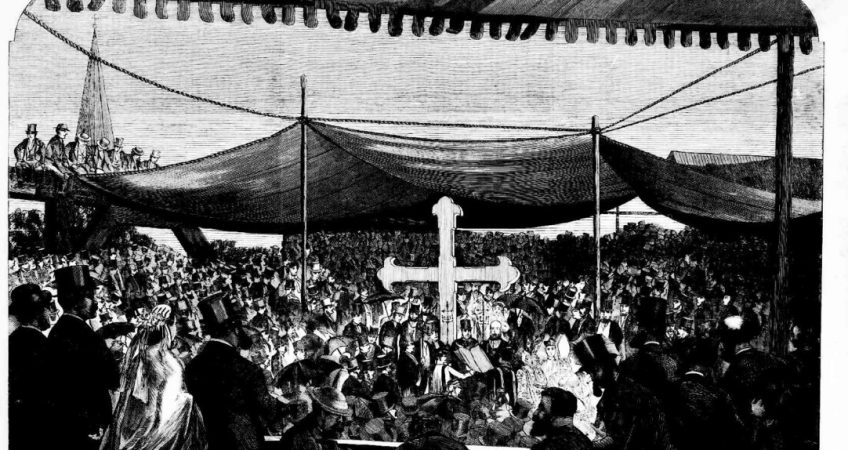
HOMILY FOR MASS OF 150TH ANNIVERSARY OF THE LAYING OF THE FOUNDATION STONE OF ST. MARY’S CATHEDRAL
St. Mary’s Cathedral Basilica, Sydney, Feast of the Immaculate Conception
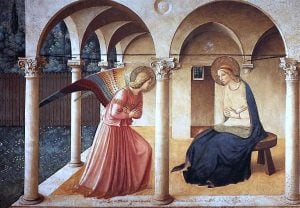
Today’s Gospel scene (Lk 1:26-38) is probably one of the most memorable in the Bible and has been one of the most frequently painted scenes for more than a millennium. From the fourth-century fresco of the Annunciation in the Priscilla catacomb in Rome, through the great Byzantine icon tradition, to the frescoes and stained glass windows of the gothic period, the painted altarpieces of the Renaissance, through to many modern works, every serious master painter has given it a go. My favourite is by the patron saint of artists and Dominican Blessed, Fra Angelico, who produced around a dozen Annunciations, from miniatures to altarpieces, paintings to wall frescoes. In the Chancery we pray the Angelus each day in front of one – sadly, not the original. Demonstrating that members of religious orders can be as one-eyed as football club members, in that work at the Polding Centre Angelico has Mary dressed in the black and white team colours of the Dominicans and situated in the team stadium of the Dominican Priory of San Marco in Florence.
It’s remarkable what a variety of portrayals we have of that simple scene, even by the same artist. The late mediaevals differentiated successive stages of the Annunciation story – ‘the Salutation’, ‘the Colloquy’, ‘the Mission’ and so on; each of these was distinguished into multiple moments also: in the Colloquy with the Angel, for instance, Mary was said to have experienced five consecutive spiritual conditions of disquiet, reflection, inquiry, submission and merit. For painters this was a goldmine of inspired possibilities. The Virgin Annunciate could sit quiet in contemplation, recoil in fear, kneel in humility, interrogate the angel like a barrister, or sit composed as a queen .
Each masterpiece since Luke’s Gospel has sought to capture something of this extraordinary event in the history of salvation. Our readings today present the Annunciation as the hinge between the old and the new covenants (Gen 3:9-15,20; Lk 1:26-38): for at this moment God’s promise to ‘crush the serpent’s head’ finds its fulfilment as salvation takes form. Gabriel speaks in the voice of the Old Testament with his talk of “Hail Mary… Holy Spirit… Son of the Most High God… successor of King David… ruler over the House of Jacob”. Mary, who in Fra Angelico’s works generally has the Bible in her lap, knew such words referred to the long hopes of Israel and the promises of the Prophets.
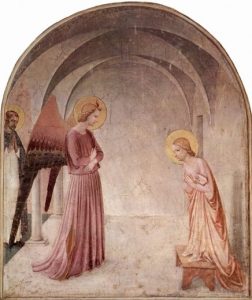
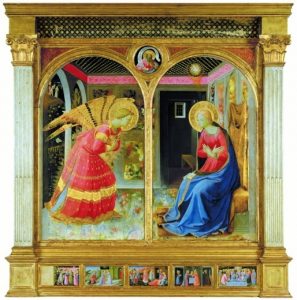
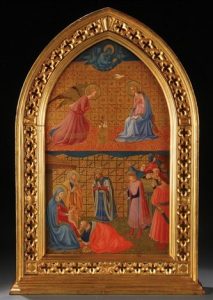
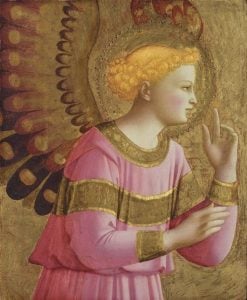
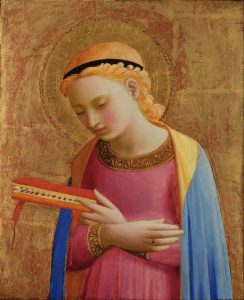
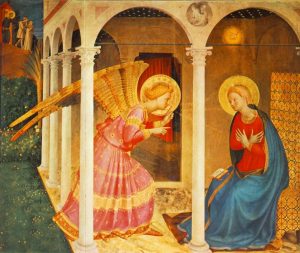
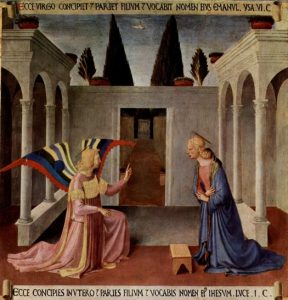
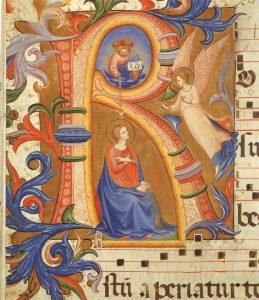
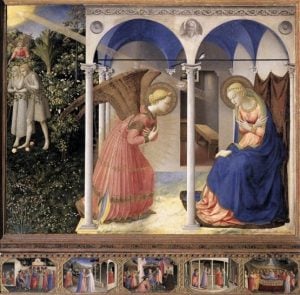
The ancient fathers imagined creation hushed at this moment. Adam and Eve are there – and all humanity – waiting in Limbo for their release. The patriarchs and prophets, are there too, the good women and wise men of old, all stand around listening. So, too, the angels, the animals, the earth and heavens: even the sun and moon eavesdrop attentively. What will the woman say? The first Eve said No, I will not obey, I will not observe your divine commands, I will not serve. But this New Eve, what will she say? “Fiat, yes, I’m God’s handmaid, I will obey, I will observe, I will serve.” Creation bursts with an excitement greater than the crowd as newlyweds come forth from a church, or a rocket lifts off, or the new year is counted down. For Mary’s ‘Yes’ is not just the Yes of a faithful, humble, holy young woman. No, Mary stands as spokesperson for creation, and willingly accepts God’s offer of re-creation. And for this she was pre-emptively rewarded by being the Type for all humanity’s salvation, immaculate from her very conception.
The implications of today’s Feast are many, but let me reflect with you upon one. It’s often said that “to sin is human”, or that some peccadillo is “only human”. But do we really mean that we are being most truly ourselves when we choose evil? When we say someone is acting ‘humanely’, or is a true ‘humanitarian’, or that Jesus was ‘fully human’, do we mean these people are prime examples of sin and vice?
Our Feast proclaims the Catholic faith that in prospect of her Yes and her Son’s saving work, she was pre-redeemed – preserved free from all stain of sin from the first moment of her conception. Sin was no part of God’s plan for the first Eve and so no part of His plan for us. When we choose evil we are not being true to ourselves; we are diminishing and demeaning our humanity, making ourselves inhuman. The two Eves remind us that as sin had no part in the beginning of our race, so it will have no place in its perfection in heaven.
Now, if sinlessness is our true beginning and our true end, it’s our best course in-between. St Thomas Aquinas said “The most perfect and the finest kind of victory is this: like Mary, never to have yielded even once to the enemy”. This is a challenge to us, but we should never think sin and vice are inevitable. In the two Eves we see we have a choice to make. Either to be less human, less in communion with God, or to be more human and so more divine.
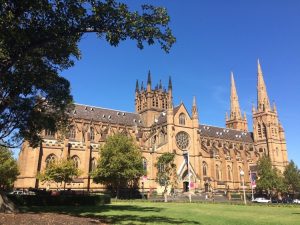
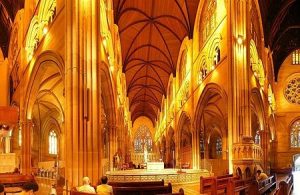
We gather today to celebrate two women: one, mother of the Church universal; the other, the mother church of Australia. We celebrate the day that this cathedral was conceived on the day that its patron was conceived. And both stand as beacons of light and hope.
When Fr John Joseph Therry, who is buried in the crypt below this basilica, first obtained the grant of land here and raised funds for the building of the old St Mary’s Chapel, it was Governor Macquarie who laid the foundation stone (1821) as there was no bishop to do so. But when the first Archbishop, John Bede Polding, arrived in 1835 the chapel immediately became the cathedral, the place housing his cathedra or bishop’s chair. The church was enlarged and modified in the “Gothic Revival” style of Augustus Pugin and would no doubt have kept evolving had it not burnt to the ground in 1865.
This was no doubt a terrible blow for the colonial Catholic community, but Polding bravely turned to Pugin’s friend William Wardell to design an even grander neo-gothic cathedral. Planning and fundraising began, and a new foundation stone was laid one hundred and fifty years ago today. By 1882 enough was completed to allow Archbishop Roger Vaughan to dedicate it liturgically and open it for use by the faithful. By 1900 Cardinal Patrick Moran had the central tower completed; he had his coadjutor and eventual successor, Archbishop Michael Kelly dedicate it in 1905 when the cathedral was at last debt-free. But there was still much to do and in 1913 Archbishop Michael Kelly laid the foundation stone for the new nave, which was consecrated in 1928.
Every generation makes its contribution and so work was continued under Cardinals Gilroy, Freeman, Clancy and Pell. Saints Mary MacKillop, Paul VI, John Paul II and Teresa of Calcutta all visited. During the World Youth Day celebrations in 2008, Pope Benedict XVI consecrated the present altar and blessed the much-loved painting of Our Lady of the Southern Cross. Only three years ago I had the privilege to bless the French-Gothic sanctuary lamp and statues of women saints in the Lady Chapel reredos. So this grand old lady that is our cathedral continues to be adorned anew by each generation, ensuring that in the heart of our city is a place of beauty, prayer and pilgrimage for Catholics and visitors alike. Only this week, as we launched the Lights of Christmas projected upon the cathedral façade each night until the 25th, the Premier of our state said this was surely one of the most stunning buildings in our country and, indeed, our hemisphere.
With pride today we celebrate that heritage but also recommit ourselves to God and His kingdom, to this city and her people, and to that faithful woman for whom St Mary’s is named, who pointed always to her divine Son. Pray for us Immaculate Mother! Pray for us Help of Christians! Pray for us Our Lady of the Southern Cross!
INTRODUCTION TO MASS FOR 150TH ANNIVERSARY OF THE LAYING OF THE FOUNDATION STONE OF ST. MARY’S CATHEDRAL
St. Mary’s Cathedral Basilica, Sydney, Feast of the Immaculate Conception
Welcome to St Mary’s Cathedral for the Feast of the Immaculate Conception of the Blessed Virgin Mary and the Sesquicentenary of the laying of the foundation stone for this remarkable basilica. After the fire of 1865 destroyed the first St Mary’s, it took enormous courage and faith in Divine Providence for the mostly poor Catholic community, under the leadership of my venerable predecessor Archbishop Polding, to set about building this monumental cathedral. It is right that we, who have inherited the building they began 150 years ago, should honour their efforts, thank the Lord who brought us together in His Mystical Body, the Church, and seek His blessing on the Catholics of today as we strive to live out our faith and share it with others.
The predecessor of The Catholic Weekly, The Freeman’s Journal, reported on 12 December 1868 that:
On Tuesday last, the imposing ceremony of blessing and laying the foundation stone of St Mary’s Cathedral, was performed by His Grace the Archbishop. That day was chosen, being the festival of the Immaculate Conception of the Blessed Virgin Mary, because the future cathedral will be erected in her honour, and bear her name… …
Early on Tuesday morning the merry peals from the towers of our churches announced that something unusual was going to happen that day… Preparations had been made for a large gathering, but the crowds were even more numerous than was anticipated. On the north western portion of the enclosure was a large tent, in which those that were invited were accommodated, and facing them and a few feet from the spot where the future High Altar will stand, upon which was erected a large wooden cross, and at a distance of some thirty feet was a platform for His Grace and the clergy where the greater part of the ceremony was performed.
On that day, 150 years ago, the clergy wore birettas, the gentlemen top-hats and the ladies long veils. Our VIPs today are every bit as grand, even if their headdress is not, and include the Auxiliary Bishop of Sydney, Most Rev. Anthony Randazzo; the Dean of Sydney, Very Rev. Don Richardson; the Judicial Vicar, Very Rev. Julian Wellspring; and other clergy; Dr Dierdre Palmer, National President of the Uniting Church of Australia; Mr Justice Francois Kunc of the Supreme Court of NSW; Professor Hayden Ramsay representing the Australian Catholic University; and others.
Since her rebirth, St Mary’s has become one of the largest and most beautiful cathedrals in the Southern hemisphere, and she’s even had the title of basilica bestowed upon her! So today we gather to celebrate them both: one, mother of the Church universal; the other, the mother church of Australia. To everyone present, a very warm welcome!

